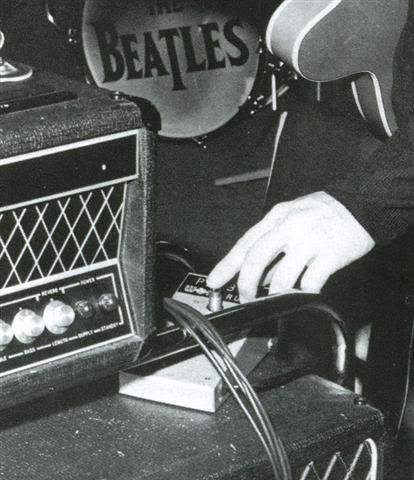This is what the original looked like - same size and shape as the Maestro, same controls, different colour.
There's a picture of John Lennon in the studio recording Revolver, with a box like it. You can see the shape and a few letters that look like they might say "PEP BOX" with a WEM logo, but it's not at all clear whether this is the same thing as the red pedal which seems to have been called the Fuzzy. Nobody knows!
This photo has been discussed at length, and Beatles nerds are fairly sure it wasn't used on the finished album, so it's a bit of a mystery. Rush did make a deal with WEM (Watkins Electric Music!) to produce a fuzz pedal in 1966, but the WEM pedal that eventually came out is a flat box with wooden sides and a different circuit using the more stable Silicon transistors. The original uses Germanium transistors - they are more difficult to get to sound right, but the fuzz sound is better to my ears - smoother, looser, woollier and more compressed. Here's the schematic and stripboard (or veroboard) layout I used:
... and an interior photo:
This is slightly different from the layout, because I niftily mounted the board on the PEP control. I also added a small bulb (not an LED), so you can tell when it's on: I used Newmarket NKT213 PNP Germanium transistors - they're normally quite rare and expensive but I got lucky with a box of 20. The original transistors are unmarked, but have the same metal can package. NKT213s are also used in the Burns Buzzaround (more on that later.) The original owner of the red pedal above sold it soon after. He didn't like it, saying it was like the typical can-of-bees 60s fuzz, like the Fuzztone. I think he's more into the heavier sounding 70s pedals. I haven't heard the original, but with these transistors, it's a much fuller bassier sound than the slightly screechy (in a good way) Fuzztone, and it's also a lot louder. The PEP control behaves much like the Attack pot on the FZ1, but where the only good position on the original is full-on, the PEP pot gives good fuzzy sounds all the way back to about the 6 o'clock position. I think it's down to the transistors. I like the way it sounds now, but often I'll change them around, try different ones after a few months, as I use sockets rather than soldering them direct to the board. It's amazing how different they sound to each other. Battery access is awkward in most DIY pedals - you have to unscrew the bottom most of the time - I solved this problem by bending the back panel inwards and mounting the batteries there, on the outside - a little bit like another early guitar pedal, the Dallas Rangemaster treble boost, which is sort of the look I was after for this one. I haven't decided how to do the sound clips yet, that's for the future. There's a whole bizarre vocabulary that has grown up to attempt to describe the many sounds of Fuzz that people use on the DIY forums I spend time on. I'll try to avoid these terms, but it's hard to describe the nuances of one fuzz compared to another - it might get difficult as time goes on - I'll need the sound clips. Once I thought that all fuzz pedals sounded the same. Now I'm a fuzz geek, cursed with trying to explain why they don't all sound the same!









